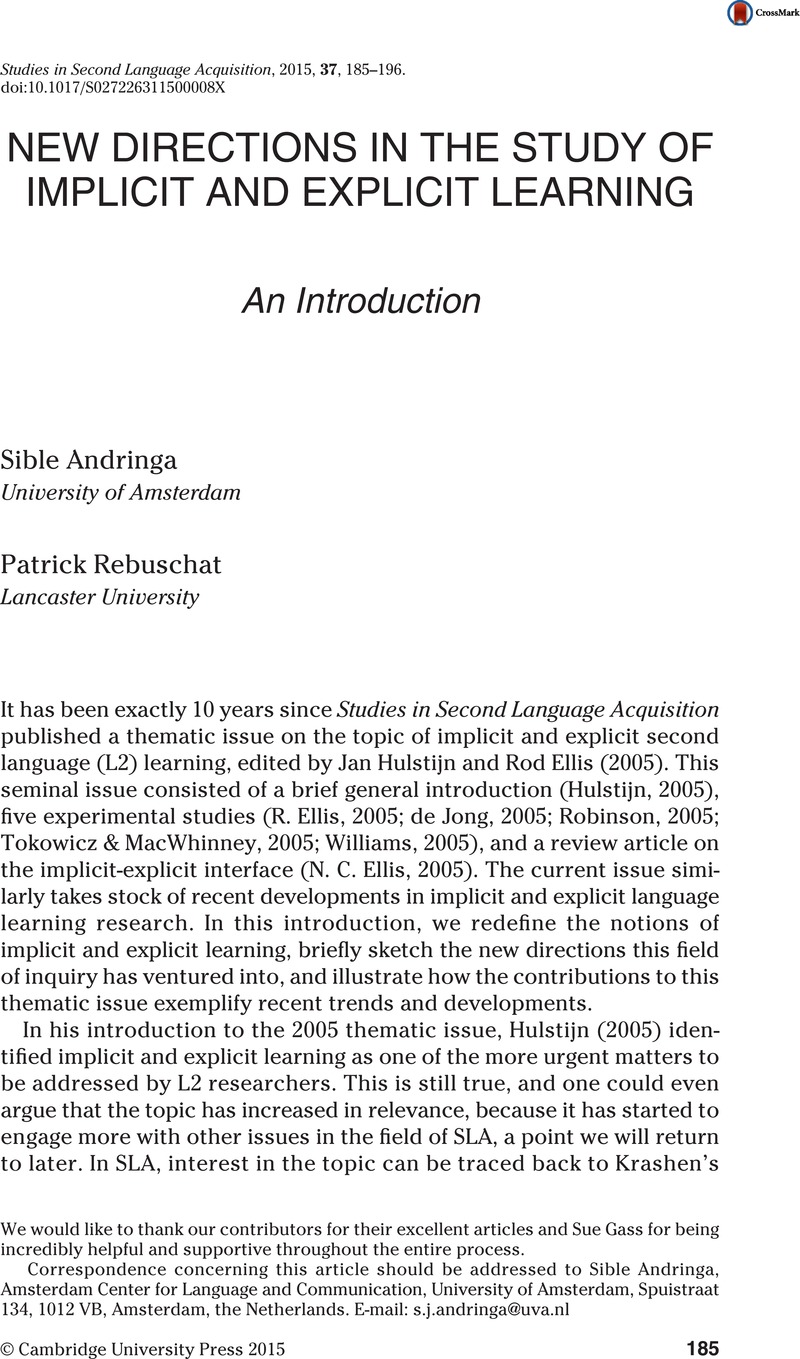Crossref Citations
This article has been cited by the following publications. This list is generated based on data provided by Crossref.
Chachu, Sewoenam
Granget, C.
Dat, M.-A.
Guedat-Bittighoffer, D.
and
Cuet, C.
2017.
The intermediary role of reformulation in learning French as a foreign language: The case of students at the University of Ghana..
SHS Web of Conferences,
Vol. 38,
Issue. ,
p.
00007.
Suzuki, Yuichi
and
DeKeyser, Robert
2017.
The Interface of Explicit and Implicit Knowledge in a Second Language: Insights From Individual Differences in Cognitive Aptitudes.
Language Learning,
Vol. 67,
Issue. 4,
p.
747.
Rebuschat, Patrick
Meurers, Detmar
and
McEnery, Tony
2017.
Language Learning Research at the Intersection of Experimental, Computational, and Corpus‐Based Approaches.
Language Learning,
Vol. 67,
Issue. S1,
p.
6.
Navidinia, Hossein
Beidokhti, Zeinab
and
Hekmati, Nargess
2017.
English Language Learners’ Big Five Personality Characteristics and Their Preference for Isolated or Integrated Form-Focused Instruction.
The Asia-Pacific Education Researcher,
Vol. 26,
Issue. 1-2,
p.
75.
Falkert, Anika
Granget, C.
Dat, M.-A.
Guedat-Bittighoffer, D.
and
Cuet, C.
2017.
Assessing implicit phonological knowledge through accent imitation.
SHS Web of Conferences,
Vol. 38,
Issue. ,
p.
00010.
Kerz, Elma
Wiechmann, Daniel
and
Riedel, Florian B.
2017.
IMPLICIT LEARNING IN THE CROWD.
Studies in Second Language Acquisition,
Vol. 39,
Issue. 4,
p.
711.
Pélissier, Maud
Krzonowski, Jennifer
Ferragne, Emmanuel
Granget, C.
Dat, M.-A.
Guedat-Bittighoffer, D.
and
Cuet, C.
2017.
Does better explicit knowledge of a morphosyntactic structure guarantee more native-like electrophysiological processing? An ERP study with French learners of English.
SHS Web of Conferences,
Vol. 38,
Issue. ,
p.
00002.
Granget, Cyrille
Dat, Marie-Ange
Guedat-Bittighoffer, Delphine
Cuet, Christine
Granget, C.
Dat, M.-A.
Guedat-Bittighoffer, D.
and
Cuet, C.
2017.
Connaissances et Usages en L2 : nouvelles perspectives.
SHS Web of Conferences,
Vol. 38,
Issue. ,
p.
00001.
Cerreta, Adelle G.B.
Vickery, Timothy J.
and
Berryhill, Marian E.
2018.
Visual statistical learning deficits in memory-impaired individuals.
Neurocase,
Vol. 24,
Issue. 5-6,
p.
259.
Ullman, Michael T
and
Lovelett, Jarrett T
2018.
Implications of the declarative/procedural model for improving second language learning: The role of memory enhancement techniques.
Second Language Research,
Vol. 34,
Issue. 1,
p.
39.
Green, Kieran
and
Schwieter, John W.
2018.
Using more native-like language acquisition processes in the foreign language classroom.
Cogent Education,
Vol. 5,
Issue. 1,
p.
1429134.
Spit, Sybren
Andringa, Sible
Rispens, Judith
and
Aboh, Enoch O.
2019.
The opt out paradigm.
Dutch Journal of Applied Linguistics,
Vol. 8,
Issue. 2,
p.
206.
Flyman Mattsson, Anna
2019.
Teachability and Learnability across Languages.
Vol. 6,
Issue. ,
p.
51.
Rebuschat, Patrick
and
Monaghan, Padraic
2019.
Editors’ Introduction: Aligning Implicit Learning and Statistical Learning: Two Approaches, One Phenomenon.
Topics in Cognitive Science,
Vol. 11,
Issue. 3,
p.
459.
Suárez, Maria del Mar
and
Gesa, Ferran
2019.
Learning vocabulary with the support of sustained exposure to captioned video: do proficiency and aptitude make a difference?.
The Language Learning Journal,
Vol. 47,
Issue. 4,
p.
497.
Nemati, Majid
Alavi, Sayyed Mohammad
and
Mohebbi, Hassan
2019.
Assessing the effect of focused direct and focused indirect written corrective feedback on explicit and implicit knowledge of language learners.
Language Testing in Asia,
Vol. 9,
Issue. 1,
Coetzee-Van Rooy, Susan
2019.
The Palgrave Handbook of Motivation for Language Learning.
p.
471.
Curcic, Maja
Andringa, Sible
and
Kuiken, Folkert
2019.
The Role of Awareness and Cognitive Aptitudes in L2 Predictive Language Processing.
Language Learning,
Vol. 69,
Issue. S1,
p.
42.
van der Ploeg, Mara
Keijzer, Merel
and
Lowie, Wander
2020.
Methodological concerns and their solutions in third-age language learning studies.
Dutch Journal of Applied Linguistics,
Vol. 9,
Issue. 1-2,
p.
97.
Andringa, Sible
2020.
The emergence of awareness in uninstructed L2 learning: A visual world eye tracking study.
Second Language Research,
Vol. 36,
Issue. 3,
p.
335.





